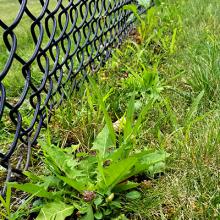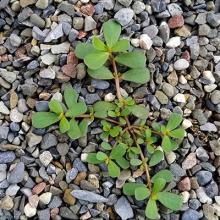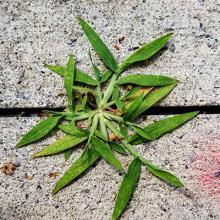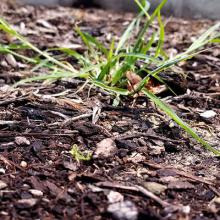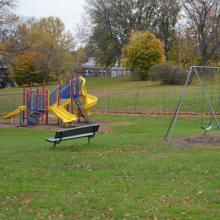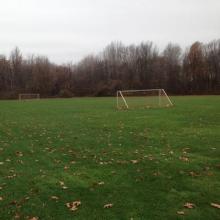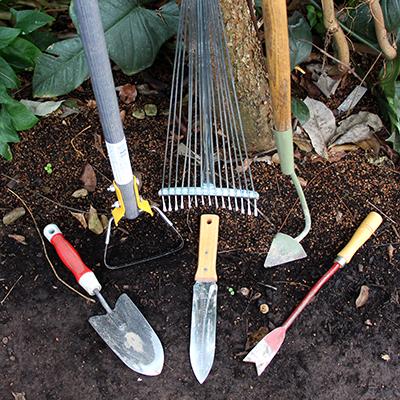
Mechanical weeding is one of the primary methods of managing weeds in a landscape. Several types of mechanical weed control are appropriate for turf and landscape environments. This page will provide an overview of some mechanical weeding tools and techniques. For more information on mechanical weed control in specific setting, please visit the environmental page of interest.
Hand Weeding
Hand weeding is the most basic form of mechanical weeding. While it is effective, it can be very labor intensive and slow especially when weeding a large area.
Weeds with fibrous roots are most easily pulled by hand. Perennial weeds, especially those with vegetative reproduction structures such as taproots and rhizomes, can be very difficult to completely remove by hand. Weeds with taproots are pulled more easily when the soil is wet.
Hand Tools
Weeding with hand tools has many advantages over hand weeding. It is generally less labor intensive than pulling weeds by hand and can be used for a wide range of weeds. A wide range of hand tools are available, allowing the user to tailor their tool choice to the environment.
Soil Knife
Also called a hori-hori, a soil knife is a useful tool in garden, turf, and landscape environments. This tool typically has a 6-8 inch blade with one smooth edge and one serrated edge. It has several uses including:
- Digging up and prying weeds from the ground.
- Cutting sod, roots, and other resistant materials.
- Removing weeds from between brick, stones, and pavers.
Paving Knife
Also called a patio knife, this tool has a L-shaped blade. Generally, both the straight and curved sides have an edge. It is best suited to:
- Remove weeds and other debris from paver joints and other crevices.
- Pry stones caught in joints.
- Cut and dig up plant roots and other structures.
Paving Brush
Instead of a blade, this tool ends in a wire bristle brush. Like the paving knife, this tool removes weeds and other debris from paver joints and other crevices. It works best on mosses and small, non-established weeds. Some paving brushes include a small blade which can more aggressively remove weeds from between pavers or slabs.
Dandelion Weeder
Also called a fishtail weeder, this tool has a shaft that ends in a two-pronged fork. It is good for removing dandelions and other weeds with taproots. One variation is a ball weeder. Instead of a straight shaft, it has a curved piece of metal or a ball along the shaft. This acts as a pivot point which gives the user more leverage and makes prying up weeds easier.
Scuffle Hoe
Also called a hula or stirrup hoe, this tool consists of a handle attached to a moveable, stirrup-shaped blade that can be used in both a push and pull motions. The blade cuts just below the soil surface and snags weeds at the root. Scuffle hoes can be particularly useful in mulched environments.
Mowing
Mowing is one of the most commonly used weed control methods in turf and landscape environments. Many broad leaf weeds are intolerant of repeated mowing; however, mowing is generally ineffective at controlling low-growing, prostrate weeds. Mowing can be used to:
- Prevent weeds from going to seed.
- Minimize seed rain.
- Exhaust carbohydrate reserves of perennial weeds.
String Trimmer
Also called line trimmers and weed-whackers, string trimmers are typically used to trim grass and cut back weeds. This tool is good for cutting weeds in tight spaces or those not easily reached by a mower. String trimmers require certain technique for optimal use and results. Here are some tips to using a string trimmer:
- Pay attention to spin direction. For clockwise spin, work from right to left and vice versa for counter clockwise spin.
- Work in the direction so that clippings are thrown away from the "clean" area.
- Trim at a consistent height.
Safety Considerations
String trimmers are one of the most dangerous lawn and landscaping tools. Follow these tips to minimize risk of injury:
- Check the ground before trimming for loose debris such as glass, metal, small stones, etc.
- Wear appropriate personal protective equipment (PPE). These include long sleeves, long pants, closed-toed shoes, gloves, eye protection, and ear protection.
- Avoid wearing loosely draped clothing or things that can be caught by the spinning head.
- Be aware of your surroundings. Stop trimming if people are around or until they have passed.
- If using a gas powered trimmer, start it outside. Turn off the engine when refueling.
Harrowing
A chain harrow, also called a drag harrow, can be an effective way to remove weeds from gravel and other loose surfaces. It looks like a section of chain link fence with a claw at each link intersection. As it is dragged along, the harrow catches on and uproots weeds. It is a relatively inexpensive piece of equipment, but requires something to pull it such as an ATV or small tractor.


